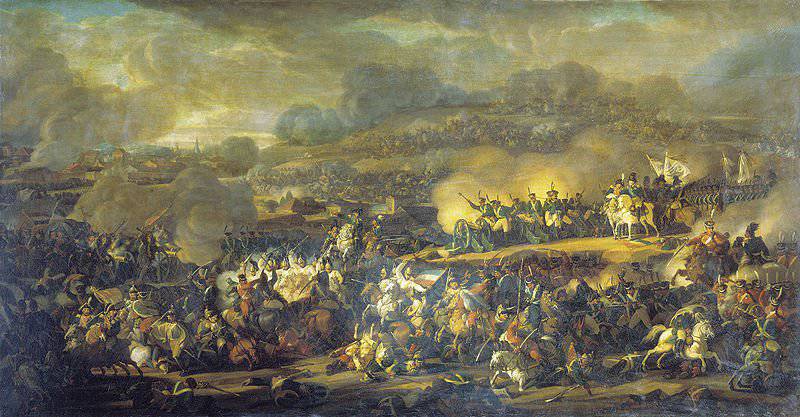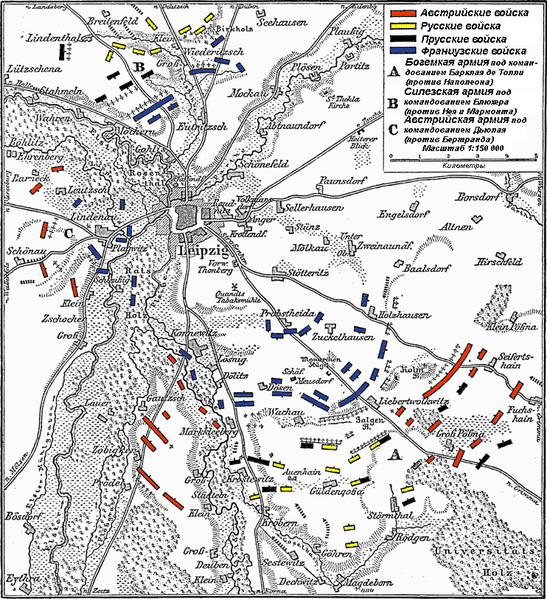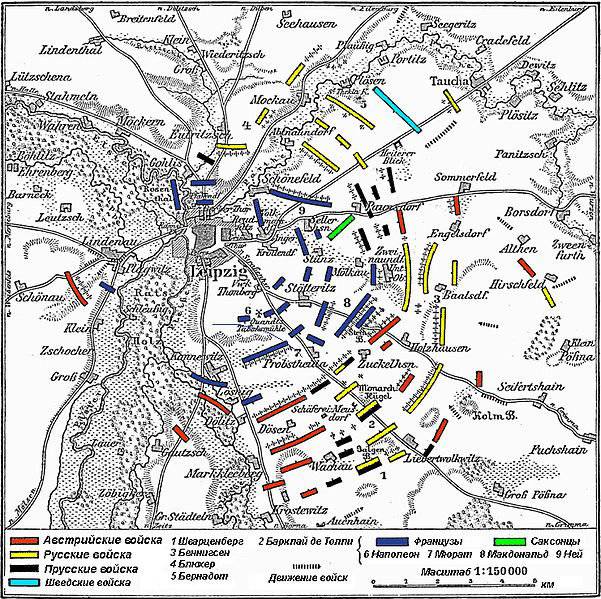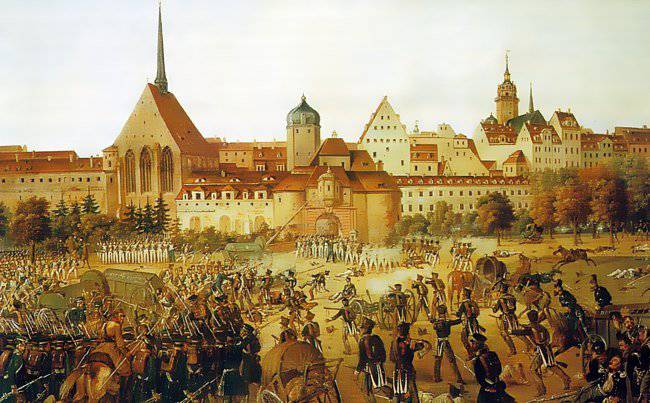The Battle of Peoples

After defeat in Russia and returning to Paris, Napoleon developed a stormy activity to create a new army. I must say that it was his peculiarity - during the crisis situation, Napoleon was awakening a huge energy and working capacity. Napoleon 1813’s “sample” of the year seemed better and younger than the 1811 emperor of the year. In his letters to the allies, the monarchs of the Rhine Union, he reported that one should not believe the Russian messages; Of course, the Great Army suffered losses, but remains a mighty force in 200 thousand fighters. In addition, the empire still has 300 thousand soldiers in Spain. Still, he asked the Allies to take measures to increase their troops.
In reality, in January, Napoleon already knew that the Great Army was no more. The chief of staff, Marshal Berthier, told him briefly and clearly: "The army no longer exists." Out of half a million people, half a year ago, marching the crossed Neman, few returned. However, Napoleon was able to form a new army in just a few weeks: by the beginning of 1813, he had assembled thousands of fighters under his banners 500. True, France was deserted, they took not only men, but also young men. 15 April, the French emperor moved to the location of the troops. In the spring of 1813, there was still an opportunity to make peace. The Austrian diplomat Metternich persistently offered his mediation in achieving peace. And the world, in principle, was possible. Petersburg, Vienna and Berlin were ready for negotiations. However, Napoleon makes another fatal mistake - he does not want to make concessions. Still confident in his talent and the power of the French army, the emperor was convinced of victory. Napoleon was hoping for a brilliant revenge on the fields of Central Europe. He still did not understand that defeat in Russia is the end of his dream of a pan-European empire. The terrible blow inflicted in Russia was heard in Sweden, Germany, Austria, Italy and Spain. In fact, a turning point in European politics has come - Napoleon was forced to fight already with most of Europe. The army of the sixth anti-French coalition opposed it. His defeat was a foregone conclusion.
Originally, Napoleon was still victorious. The authority of his name and the French army was so great that the commanders of the sixth coalition lost even those battles that could be won. 16 (28) April 1813, the death overtook the great Russian commander, hero of the Patriotic War 1812, Mikhail Illarionovich Kutuzov. He actually died in battle formation. The whole country mourned his passing. Peter Hristianovich Wittgenstein was appointed to the post of commander-in-chief of the Russian army. 2 May 1813 battle took place at Lutzen. Wittgenstein, having originally a numerical advantage over Nei’s corps, acted hesitantly. As a result, he delayed the battle, and Napoleon was able to quickly concentrate forces and go on the offensive. Russian-Prussian troops were defeated and were forced to retreat. Napoleon's forces again occupied all of Saxony. 20 — 21 May 1813, in the battle of Bautzen, the army of Wittgenstein is again defeated. The superiority of Napoleon's commanding genius over Wittgenstein was undeniable. At the same time, his army suffered heavy losses in both battles than Russian and Prussian troops. Alexander I replaced Commander-in-Chief P. Wittgenstein with 25 in May with a more experienced and senior officer with the rank of Michael Barclay de Tolly. Napoleon entered Breslau. The Allies were forced to offer a truce. Napoleon’s army also needed rest, the supply of French troops was unsatisfactory, and he willingly went to a cease-fire. 4 June truce was concluded.
The war resumed on August 11, but already with a significant margin in the strength of the Allies, joined by Austria and Sweden (she was promised to the Danish Norway). In addition, in mid-June, London pledged to support Russia and Prussia with substantial subsidies to continue the war. Austrian Field Marshal Karl Schwarzenberg became the commander-in-chief of the Allied armies. 14-15 (26-27) August 1813 was the battle of Dresden. The Bohemian army of Schwarzenberg had a numerical advantage, he had considerable reserves, but hesitated, allowed Napoleon to seize the initiative. The two-day battle ended in a heavy defeat for the Allied forces, who lost 20 — 28 thousands of people. The greatest losses suffered the Austrian army. The Allies were forced to retreat to the Ore Mountains. True, during the retreat, the Allied forces destroyed in the battle of 29 — 30 of August near Kulm, the French corps of Vandam.
It should be noted that Wittgenstein and Schwarzenberg suffered defeats from Napoleon not only because of their mistakes. They were often not sovereign commanders in the army, like Napoleon. In the headquarters of the commander in chief, waiting for fame from victory over the French ruler, important persons — the emperor Alexander, Grand Duke Constantine, Friedrich Wilhelm III, and Franz I. — were often spoken. They all were military men and believed that they could not do without “smart” army councils. Together with them a whole court of their advisers, generals, etc., arrived at the rate. The rate was turned almost into a court salon.
Victories at Lützen, Bautzen and Dresden only strengthened Napoleon’s faith in his star. He believed in his military superiority, underestimated the forces opposing him, misjudged the fighting qualities of enemy armies. It is clear that Wittgenstein and Schwarzenberg, as commanders, were much inferior to Napoleon, and even less in the military strategy and tactics were understood by the hostile monarchs. However, Napoleon did not notice that new victories led to other consequences, say victories at Austerlitz and Jena. The beaten army of the allies, after each defeat only intensified. The number of his enemies grew, their strength and determination to fight to the bitter end. Previously, a victory in a decisive battle crushed the enemy's army, the spirit of the country's political leadership, predetermined the outcome of the campaign. The army that fought with Napoleon's troops became different. In fact, Napoleon ceased to be a strategist in 1813, continuing to successfully resolve operational issues. Finally, his fatal mistake became clear after the so-called. "The Battle of the Nations."
Battle of Leipzig (16 — 19 October, 1813)
September 1813 of the year passed without significant battles, with the exception of another unsuccessful campaign of the French army under the command of Marshal Ney against Berlin. At the same time, the situation of the French army deteriorated: a series of minor defeats, exhausting marches and poor supply led to significant losses. According to the German historian F. Mehring, in August and September the French emperor lost 180 thousand soldiers, mainly from diseases and desertion.
In early October, the Allied forces, reinforced by fresh reinforcements, launched an offensive against Napoleon, who held strong positions around Dresden. Pushing his troops from there were going to a wide bypass maneuver from both sides at once. The Silesian Russian-Prussian army of field marshal Blucher (54-60 thousand soldiers, 315 guns) bypassed Dresden from the north and crossed the river. Elbe north of Leipzig. It was joined by the Northern Prussian-Russian-Swedish army of Crown Prince Bernadotte (58-85 thousand people, 256 guns). The Bohemian Austro-Russian-Prussian army of Field Marshal Schwarzenberg (133 thousand, 578 guns) came out of Bohemia, bypassed Dresden from the south and also moved towards Leipzig, entering the rear of the enemy. The theater of war moved to the left bank of the Elbe. In addition, the Polish Russian army of General Bennigsen (46 thousand soldiers, 162 guns) and the 1 Austrian Corps Colloredo (8 thousand men, 24 guns) were brought up during the battle. In total, the Allied forces had from 200 thousand (October 16) to 310 — 350 thousand people (October 18) with 1350 — 1460 guns. The commander-in-chief of the Allied armies was Austrian Field Marshal K. Schwarzenber; he submitted to the advice of the three monarchs. Russian troops led by Barclay de Tolly, although Alexander regularly intervened.
The French emperor, having left a strong garrison in Dresden and barred against the Bohemian army of Schwarzenberg, moved the troops under Leipzig, where he first wanted to defeat the armies of Blucher and Bernadot. However, they avoided the battle, and Napoleon had to deal with all the allied armies at the same time. Leipzig the French ruler was 9 infantry corps (about 120 thousand. Infantry and cavalry), Imperial Guard (3 infantry corps Cavalry Corps and artillery reserve, up to 42 thousand. People), 5 Cavalry Corps (to 24 thousand.), And the garrison of Leipzig (about 4 thousand soldiers). Napoleon had a total of approximately 160 — 210 thousand bayonets and sabers, with 630 — 700 guns.
The location of forces. On October 15, the French emperor deployed his forces around Leipzig. At the same time, most of his army (about 110 thousand people) was located south of the city along the river Pleisse, from Konnevittsa to the village of Markleberg, then further east through the villages of Wachau and Libertovolkvitz to Holzhausen. 12-thousand General Bertrand's corps at Lindenau covered the road to the west. In the north there were parts of Marshals Marmont and Ney (50 thousand soldiers).
The allied armies by this time had about 200 thousand bayonets and sabers available. The Polish army of Bennigsen, the northern army of Bernadotte and the Austrian corps of Colloredo only pulled up to the battlefield. Thus, by the beginning of the battle, the Allies had a slight numerical superiority. According to the plan of Commander-in-Chief Karl Schwarzenberg, the bulk of the Allied forces had to overcome the resistance of the French near Konnewitz, pass through the swampy lowland between the rivers Weisse-Elster and Pleisse, bypass the enemy’s right flank and cut the shortest western road to Leipzig. Around 20, thousands of soldiers, led by Austrian Marshal Giulai, were to attack the western suburb of Leipzig, Lindenau, and Field Marshal Blucher — to strike the city from the north, from Škoydice.
After the objections of the Russian emperor, who pointed out the difficulty of moving along such a territory (rivers, swampy lowlands), the plan was somewhat changed. To implement his plan, Schwarzenberg received only 35 thousand Austrians. The 4 Austrian Corps of Klenau, the Russian forces of General Wittgenstein, and the Prussian Corps of Field Marshal Kleist, under the general guidance of General Barclay de Tolly, were to attack the enemy head-on from the southeast. As a result, the Bohemian army was divided by rivers and marshes on the 3 part: in the west - the Austrians of Giulaya, the second part of the Austrian army attacked in the south between the rivers Weisse-Elster and Pleisse, and the rest of the troops under the command of Russian General Barclay de Tolly - in the south-east.
16 October. At about 8 in the morning, Russian-Prussian forces of General Barclay de Tolly opened artillery fire on the enemy. Then the avant-garde units went on the attack. Russian and Prussian forces under the command of Field Marshal Kleist near 9.30 occupied the village of Markleberg, which was defended by Marshals Augereau and Poniatowski. The enemy four times drove the Russian-Prussian troops out of the village and four times the Allies again took the village by storm.
Located east of the village of Wachau, where the units were under the command of the French emperor Napoleon himself, was also taken by the Russian-Prussian forces under the general command of Duke Eugene of Württemberg. True, due to losses from the shelling of enemy artillery, the village was left by noon.
Russian-Prussian forces under the general command of General Andrei Gorchakov and the 4 Austrian Corps of Klenau attacked the village of Lebertolkwitz, which was defended by the infantry corps of Loriston and MacDonald. After a fierce battle for each street, the village was captured, but both sides suffered significant losses. After the reserves were approached by the French, the allies had to leave the village to the 11 watch. As a result, the Allied offensive did not succeed, and the entire front of the anti-French forces was so weakened by the battle that it was forced to defend the original positions. The advance of the Austrian troops against Connovetz was also unsuccessful, and in the afternoon, Karl Schwarzenberg sent the Austrian corps to help Barclay de Tolly.
Napoleon decides to go on the offensive. Around 3 hours of the day before 10, thousands of French cavalrymen under the command of Marshal Murat made an attempt to break through the central positions of the Allies near the village of Wachau. Their attack was prepared with 160 artillery barrels. Cuirassiers and Murat dragoons crushed the Russian-Prussian line, overturned the Guards Cavalry Division, and broke through the center of the Allies. Napoleon even thought that the battle had been won. French cavalrymen managed to break through to the hill on which the Allied monarchs and Field Marshal Schwarzenberg were stationed, but were thrown back thanks to a counterattack by the Life Guard Cossack regiment commanded by Colonel Ivan Efremov. The Russian emperor Alexander, before others realizing that a critical moment had come in the battle, ordered the Sukanet, the Rayevsky division and the Prussian brigade Kleist to be thrown into battle. The offensive of General Jacques Lauriston’s 5 French Infantry Corps on Güldengossu ended in failure. Schwarzenberg redeployed spare parts to this position under the leadership of Grand Duke Konstantin Pavlovich.
The offensive of the forces of the Austrian Marshal Gioulaya (Gyulai) on Lydenau was also repelled by French General Bertrand. The Silesian army of Blucher achieved serious success: without waiting for the approach of the Northern army of the Swedish crown prince Bernadot (he was slow, trying to save his strength to seize Norway), the Prussian field marshal ordered to launch an offensive. Under the villages of Videritz and Mökern, its units encountered fierce resistance from the enemy. For example, Polish General Jan Dombrovsky, who defended Videritz, held positions for a whole day, fighting off Russian troops under General Langeron. 20-thousand Corps Prussian General after a series of attacks captured Meckern, who defended the corps of Marmont. The Prussians showed great courage in this battle. The army of Blucher broke through the front of the French troops north of Leipzig.
The first day did not reveal the winners. However, the fight was very fierce and the losses on both sides were significant. On the night of 16 on 17 of October, fresh armies of Bernadotte and Bennigsen approached Leipzig. The allied forces had an almost double numerical advantage over the forces of the French emperor.

The position of the troops 16 October 1813 year.
17 October. On October 17 there were no significant battles, both sides gathered the wounded and buried the dead. Only to the north, the army of Field Marshal Blucher, took the villages of Oitritsch and Golis, coming close to the city. Napoleon pulled the troops closer to Leipzig, but did not leave. He hoped to conclude a truce, he also counted on the diplomatic support of the "relative" - the Austrian emperor. Through the Austrian general Merfeld captured at Konnevittse late at night on October 16, Napoleon conveyed his armistice terms to the enemies. However, they did not even answer.
18 October. 7 o'clock in the morning Commander-in-Chief Karl Schwarzenberg ordered the transition to the offensive. French troops fought desperately, villages passed from hand to hand several times, fighting for every street, every house, every inch of land. So, on the left flank of the French, Russian soldiers under the command of Langeron from the third attack, after a terrible hand-to-hand fight, captured the village of Shelfeld. However, the reinforcements sent by Marshal Marmona dislodged the Russians from their positions. A particularly fierce battle was in full swing near the village of Probstade (Probstheide), in the center of the French positions. The corps of General Kleist and General Gorchakov were able to make their way into the village by 15 and began to seize one house after another. Then the Old Guard and General Guard Drouot’s artillery (around 150 cannons) were thrown into battle. The French troops drove the Allies out of the village, and went to the main forces of the Austrians. Under the blows of the Napoleonic Guard, the Allied lines “cracked”. The French offensive was stopped by artillery fire. In addition, Napoleon betrayed the Saxon division, and then the Württemberg and Baden units.
The fierce battle lasted until the night, the French troops retained all the main key positions, but in the north and east the Allies came close to the city. French artillery spent almost the entire ammunition. Napoleon gave the order to retreat. Troops under the command of MacDonald, Ney and Loriston remained in the city to cover the retreat. At the disposal of the retreating French army was only one road to Weissenfels.

The position of the troops 18 October 1813 year.
19 October. The Allies planned to continue the fight in order to force the French to surrender. Reasonable proposals by the Russian sovereign for forcing the Pleisse River and Prussian Field Marshal Blucher for the allocation of 20 thousand cavalry to pursue the enemy were rejected. At dawn, realizing that the enemy had cleared the battlefield, the Allies moved on to Leipzig. The city was defended by the soldiers of Poniatowski and MacDonald. Loopholes were punched in the walls, arrows were thrown in the streets, among trees, gardens, and tools were placed. Napoleon's soldiers fought desperately, the battle was bloody. It was only by the middle of the day that the Allies managed to seize the outskirts, knocking out the French with bayonet attacks. During the concomitant hasty retreat of the confusion, the sappers blew up the Elsterbruecke Bridge, located in front of the Randstad Gate. At this time, there were still about 20-30 in the city with thousands of soldiers of MacDonald, Poniatowski and General Loriston. Panic began, Marshal Jozef Ponyatovsky, attempted to organize a counterattack and organized retreat, was twice wounded and drowned in the river. General Loriston was captured, MacDonald barely escaped death, swimming over the river, thousands of French were captured.

Battle at the Grimm Gate 19 October 1813 of the year. Ernst Wilhelm Strasberger.
Battle results
- The victory of the Allies was complete and had a pan-European significance. The new army of Napoleon was completely defeated, the second campaign in a row (1812 and 1813) ended in defeat. Napoleon led the remnants of the army to France. Saxony, Bavaria, moved to the side of the Allies, the Rhine Union of the Germanic states subjugated to Paris collapsed. By the end of the year, almost all French garrisons in Germany capitulated, so Marshal Saint-Cyr surrendered Dresden. Napoleon was left alone against almost all of Europe.
- The French army lost about 70 — 80 thousand people under Leipzig, of which about 40 thousand killed and wounded, 15 thousand prisoners, another 15 thousand were captured in hospitals, surrendered to 5 thousand Saxons and other German soldiers.
- The losses of the Allied armies totaled up to 54 thousand killed and wounded, of which about 23 thousand Russian, 16 thousand Prussians, 15 thousand Austrians and only 180 Swedes.
Information